A Spring Symphony
Thursday, April 30, 2015
On 29th March I began my 40th year at Cilgwyn Lodge. I don't
know where the time has gone but spring has always been special
here, surrounded as we are by open fields full of sheep and lambs
and bluebells everywhere. There used to be curlews and lapwings,
hares too, but sadly no more. Cuckoos have rarley been heard
in the last 15 years. Otherwise April continues to delight us with
its unique quality of light, the indelible freshness of new
grass and the breaking of buds. It is also a time to reflect on
what we have achieved in the gardens. Fortunately we have "before
and after" pictures. There is so much to celebrate in April but
there is often a sting in the tail too. Not for nothing is April
dubbed "the cruelest month.
Cilgwyn Lodge 25 August 1969

Cilgwyn Lodge May 2009
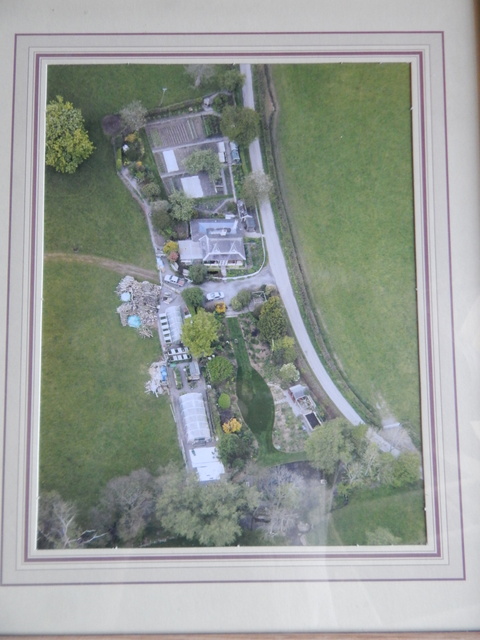
Weather
The weather pattern established in March has continued
throughout April with some fine days but consistently cold nights.
Plenty of sunshine but precious little rain, our weather for the
most part coming from an easterky direction as it often does at
this time of year. There were 11 daytime temperatures above
15C (max 19.2C on 10 April) and 16 night temperatues below 4C (min
-3C on 27th). It is the sort of weather that is really fabulous for
everyone except gardeners and farmers!!
Garden Update
The fine weather at last enabled us to really get cracking on
the gardens with rotovating of the vegetable beds completed on 10th
and potatoes all planted a week later. Nine varieties from earlies,
salad types to maincrops - 17 rows in all. I also planted out early
brassicas good old Hispi and Greyhound cabbage, cauliflower
Snowball , lettuce, onions and shallots. All later than normall but
I have long since learned to wait until the soil has properly
warmed up before planting and sowing.
Completion of potato planting

Plenty more to go out in the next couple of weeks. Tender
vegetables like beans, sweetcorn, cougettes, cucumbers, tomatoes
and peppers all growing away well now in the polytunnels for
planting out mid -late May. Late frosts here are not uncommon here,
even once in 1993 on 4 June which wrecked the potato crop and
browned off all the new growth in the hedgerows.
In the nursery Moira has been busy pricking out masses of
seedlings and repotting tender plants, iincluding the large
succulent collection she has built up over the years. It was
interesting that when re-potting them out of over 50 plants she
only found 2 which which were infected with vine weevil grubs.
Succulents appear to be their no.1 host plants here. However I read
the other day that these tiny grubs are capable in huge numbers of
decimating mature woody plants like rhododendrons and even
yews. Outdoors they are very difficult to identify and control
although excessively notched leaves on a host plant is perhaps the
most reliable means. Plants in pots are easier and there are
chemical, biological and natural predator remedies available to
home gardeners.
Some of the seedlings awaiting pricking out. I am
particularly pleased by the success of lilium martagon seed of
which there are 24 pots of seedlings from 2013 onwards. I don't
prick these out until they are at least 2 years old by which time
they have formed a transplantable small bulb - then it is only a
couple of years or so before they flower. Patience is a virtue in
gardening!
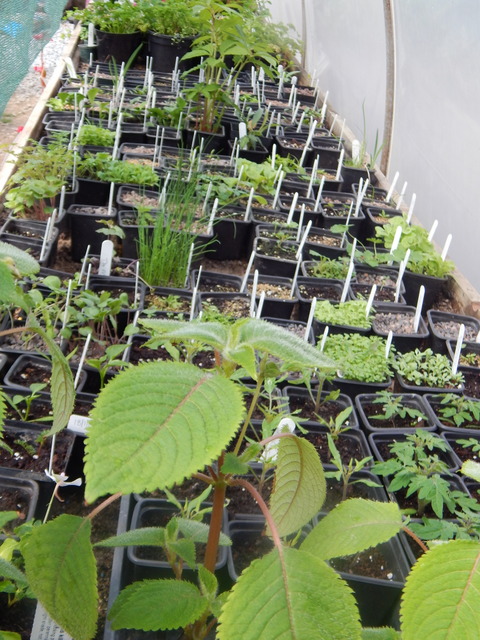
Currrently I am turning over and lightly feeding with pelletted
chicken manure all the flower borders, taking care no to damage
plants that have not yet broken into growth (overwintered dahlias,
lilies, hostas, for example). Visitors to the gardens are often
surprised that we do not feed more than that but if you feed too
much nitrogenous material they get too lush and you have
floppy stems that need excessive staking and foliage at the expense
of flowers. As soon as they are through I can see where the
gaps are and then infill them with plants from the nursey including
the many annuals we have grown. New forms of that wonderful
umbellifer ammi majus are being tried this year having seen them on
our travels last summer. And the wildflower seed from Pictorial
Meadows reported upon last month were sown in the past
week.
What's looking good?
Just too much!! So many lovely things all over the gardens - the
sights of spring are easier to convey than the scents. Viburnums
are great value plants for spring as there are so many to choose
from none better for me than viburnum Carlesii Also good for
slighly later are viibirnum "Juddii" and v. plicatum with its
attractive tiered branches.
Viburnum carlesii
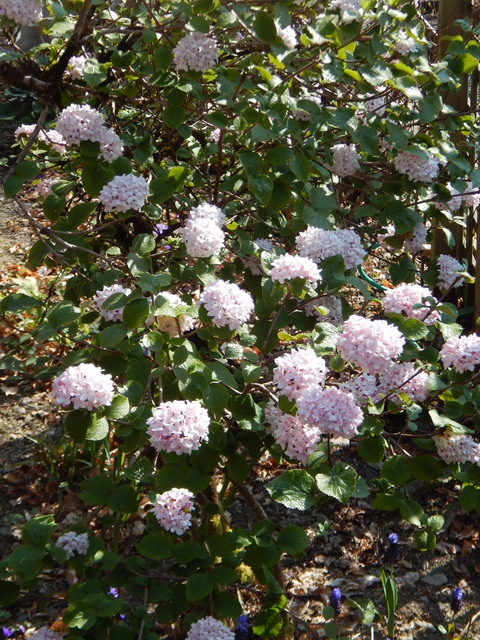
Perhaps even better is the smell of freshly cut grass and rain
on sun warmed soil, or the earthy smell of growth when you open the
polytunnel doors first thing in the morning.
Now here are some pics of the best of the very best.
Semiaquilegia adoxoides from Hardy Plant Society Seed
Exchange 2014. A real head turner that was a big hit in Dorset a
few weeks ago. Delicate and dainty and only a foot tall, it
resembles the flower of clematis alpina a close
relative.
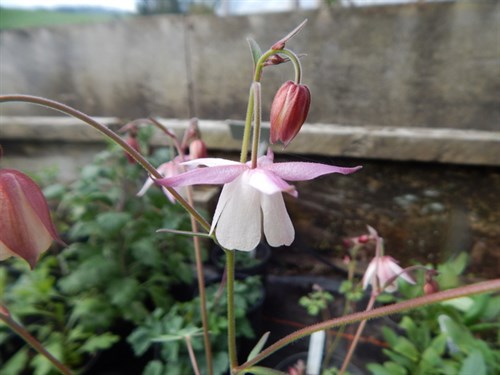
Lysichiton americanus ; not called the skunk
cabbage for nothing - like it or not it is a distinctive odour!
Marvellous though in a stream garden as here but it can become
invasive
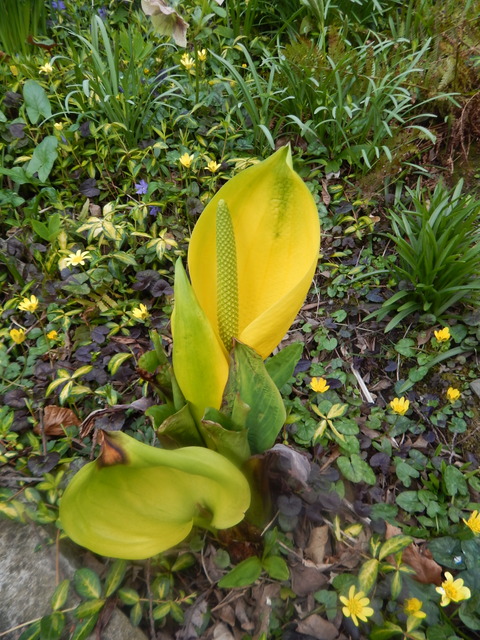
A new plant to me last year which is revelling in the
celebrity status afforded to umbellifers at present - just see
Chelsea if you don't believe me - melanoselenium decipiens from the
laurel forests of Madeira. Not totally hardy here this one had the
luxury of a heated tunnel all winter and what a show it is putting
on. 4 feet tall on a thick trunk it has mildly perfumed umbels of
white tinged purple flowers. Lovely form and habit too. It may
prove to be monocarpic so I hope it is generous with fertile
seeds.


If you are a regular visitor to our website and many
thanks if you are - at 12.15 am it is a comnfort to know you keep
up to date! you will know how passionate I am about hostas and I
was recently honoured to be asked to write an article for the 2015
edition of the Journal for The British Hosta and Hemerocallis
Society. I love them at all stages of their growth especially in
Spring just as the pips are beginning to appear, such a wide range
of forms and colours. These belong to an older cultivar "Krossa
Regal" a large elegant bluish green form.
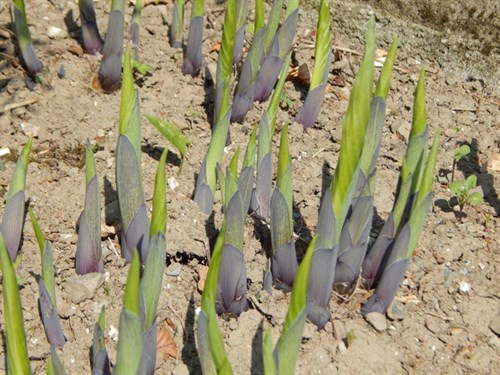
And what a stunner this one is in its first flush of the
most amazing loud yellow which gradually fades to green durring the
summer. It is " Golden Aerial" and an eagerly awaited favourite of
mine.
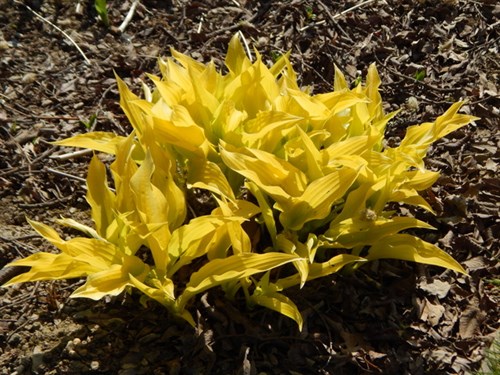
And growing close by in the woodland garden is a British
native, euphorbia robbieae with intense lime green bracts in
spring. It looks good with its companion planting of bluebells,
brunneras and cammassias. It can be very invasive but is checked
here to some extent by the very poor soil and well established tree
roots.

In complete contrast is the beautiful and elegant
Belarina primrose "Pink Ice" which in spite of its delicate looks
is bone hardy and floriferous over the whole of late winter and all
of Spring.
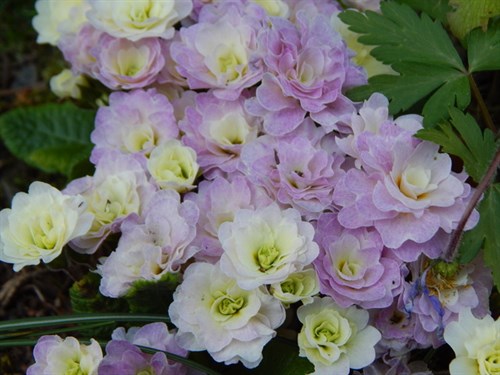
Herbaceous lathyrus vernus a good free standing pea to
18"; great for the front of a border with other spring flowering
plants. Slow growing but a welcome addition in humus rich
soil in sun or part shade
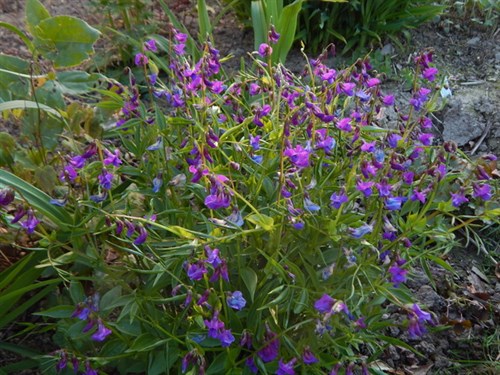
I am not a huge fan of rhododendrons and azaleas but we
do have a few in the gardens although I don't doubt they would do
well here, this in yer face deep pink has been putting on a show
every year since 1987 when the small pond which it surrounds was
made. I rather like it and being so close to the house it makes
quite a statement.

The earliest of all the arisaemas we have in the gardens
is A. nepenthoides. The flowers come well before the leaves and are
susceptible to frost so it needs to be covered with fleece on
colder nights. It is not the most spectacular flower compared to
many in the genus but place if where the late afternoon sun can
shine through it and it is transformed into a thing of intricate
beauty.
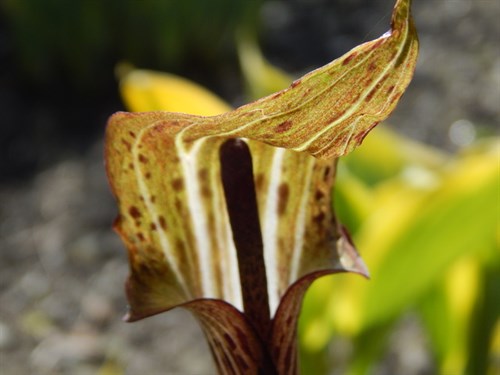
Good old down to earth vegetable purple sprouting
broccoli is cropping incredibly well and with 7 five feet tall
plants there is more than enough for us and our friends and
neighbours.
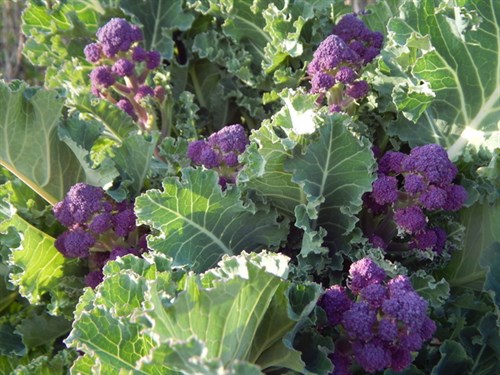
I much prefer the later daffodils than most of the large
flowered forms which seem to adorn almost every road verge near to
any centre of population. They seem so incogruous when compared to
huge drifts of native forms in woods that I knew in
Gloucestershire. Pale lemon yellow on short stout stems they are an
absolut delight. I do however prefer the later daffodil culktivars
such as the poeticus group, the jonquills and the late
cyclamineus all of which are a delight.
A long time favourite is cyclamineus "Jenny" which gives
almost a month of interest starting a good lemon yellow and
gradually fading to pure white

And I surprise myself that I like this one which is a
little fussy perhaps but has a nice habit and an ever changing
colour palette as it ages - a slight scent too. I give you "Hill
Star". A jonquilla type. Another good form in this Division is
"Pipit", more floriferous and refined paler yellow
too.

We were delighted recently to be given a very special
gift by our good friends Robert and Barry. One of the 888,246
memorial poppies from the display at the Tower of London last
autumn. It is piece of history to treasure, to remind us of the
horrors of the First World War and has a special place in the
border at the front of the conservatory
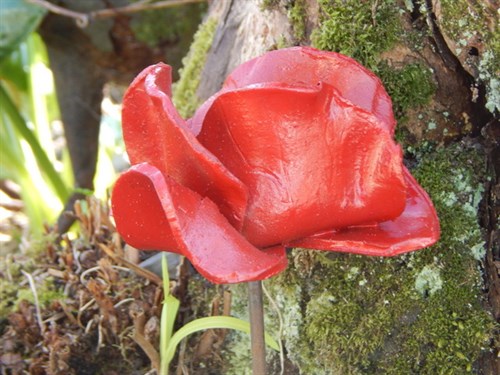
Wildlife and countryside
As the days lengthen, become warmer and new life is created
everywhere, there is a surge of activity all around us. The most
obvious are the lambs in the fields in their hundreds enjoying
their all too brief spell of "La dolce vita". The bleating of lambs
and admonishing calls from their mothers can be deafening at
times!
The blossom on the blackthorn has been amazing and long
lived throughout March and April. A vintage crops of sloes to
flavour our gin this autumn!

More quietly and almost imperceptably on 23 April was the return
of the swallows, an always anticipated event in the yearly wildlife
calendar. Plenty of other bird activity too in the hedgerows with
many birds now nesting and fledglings appearing day on day. The
first blackbird chicks were seen on 14 April keeping close to their
parents and trying to avoid the malicious attention of a pair of
magpies nesting in the fir trees with young of their own to feed
and troubled recently by crows. Green woodpeckers heard but not
seen in the valley. but no pied wagtails yet. Adult blackbirds are
by far the most frequent and loudest singers, usually in the
evening from the uppermost branches of one of the two large apple
trees.
In the bright sunshine plenty of butterflies on the wing
including small tortoishells (always the first) followed by red
admirals, commas, orange tips and meadow browns. A good start.
A comma on a hellebore leaf

Wildflowers have been at their absolute best with wood anemones,
celandines, stitchwort, violets, magnificent primroses in what must
surely be a bumper year, and latterly in woodlands and shady
banks huge drifts of bluebells and wild garlic.
Violets in long grass at the edge of an oak
wood
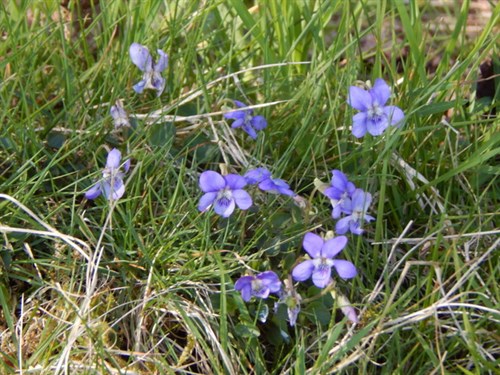
A double form of anemone nemerosa called "Vestal" at
Cilgwyn Lodge. The wild form in the hedgerows and woods is equally
impressive but devilishly difficult to photagraph in dappled
shade
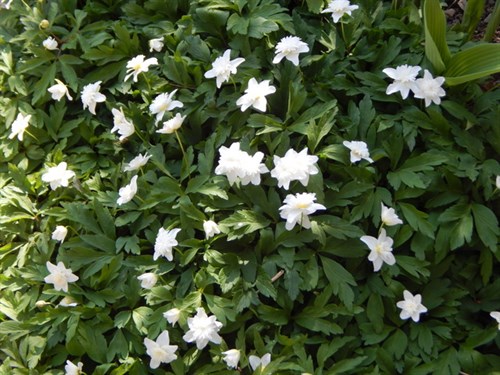
Bluebells in a vintage year for them
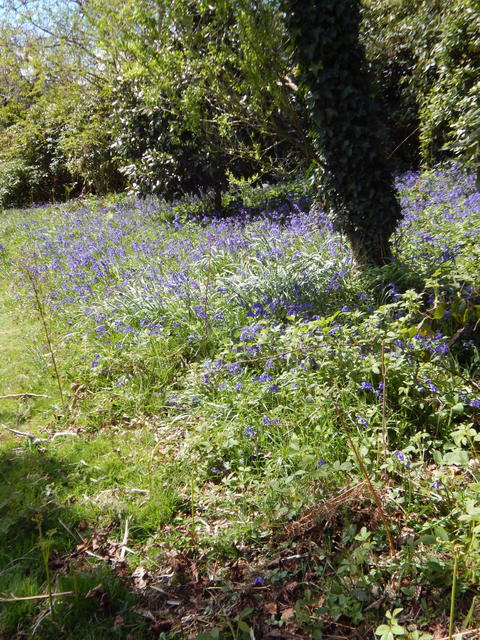
A growing colony of primroses by the fingerpost at the
end of our lane
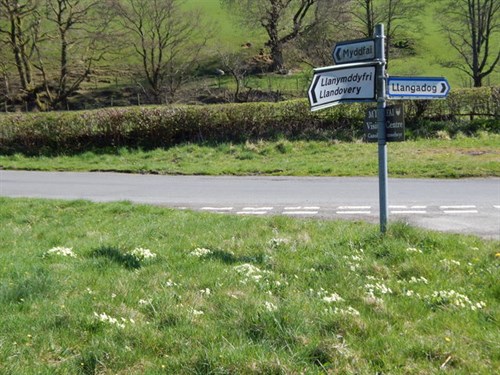
They look even better in close up
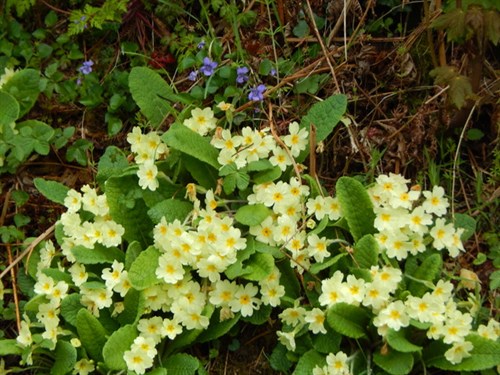
In the Paddock Pond all tadpoles have hatched but the pondweed
is so thick we can scarcely see them, but it keeps them safe from
predators. We introduecd a few more fish into the pond during the
month with a consignment of 30 crucian carp and 20 mirror carp.
Many people with wildlife ponds will not have fish in their ponds
but I do not find that they materially reduce the richness of all
layers of living organisms in the pond as they are part of the
natural order of things whose offspring is preyed upon in the same
way as all the other residents in the pond. And we still have our
mallards and a resident heron or two just to show everyone else who
is in charge!
After floating the bags the fish were transported in to
equalise the water temperatures, the fish were released to the
pond. In the murky water you can just see a Crucian Carp. All the
fish were 4 - 6 inches long
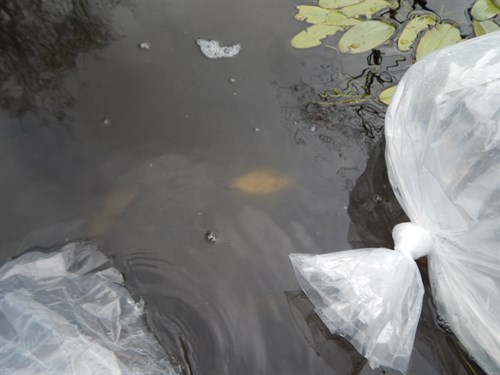
Visits
Apart from our visit to Dorset reported upon earlier this month,
we also gave talks in Narberth, Reynoldston on the Gower Peninsular
and Kidwelly. where I gave the first performance of my latest
talk entitled "Gardens I Have Known and Loved". It
turned out to have more content than I first envisaged with
so many wonderful gardens to showcase that I am preparing a
second talk under the same heading but featuring gardens in the
Cotswolds and Midlands (the first one covers gardens in the south
and west of England and Wales). With so many slides available this
could be a a long running series!
April is such a busy time of year that that there is rarely any
time left to go garden visiting but on Sunday 25th in glorious
sunshine we went to the Glanusk Estate near Crickhowell just off
the A40, opening for the NGS. One of the largest private estates in
Wales there is plenty to see not just the rolling acres of
shrub and tree "borders", but also the panoramic views from a
sheltered elevated position. Plus a great atmosphere and plenty of
stalls selling a range of crafts and gardening related items and
delicious food - particularly memorable were the best burgers I
have ever tasted all components locally sourced and
generously filled. It makes you realise how good a burger can be -
large chains please take note!
Views from the gardens at Glanusk
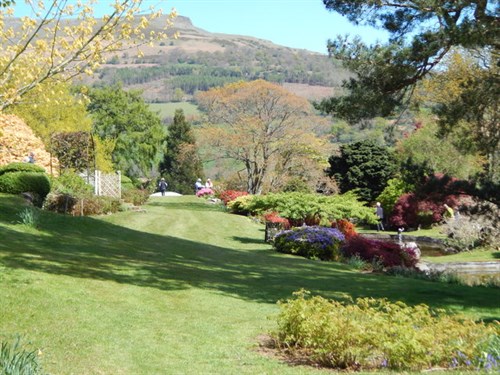
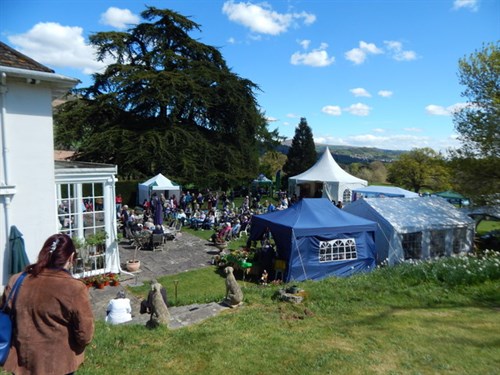
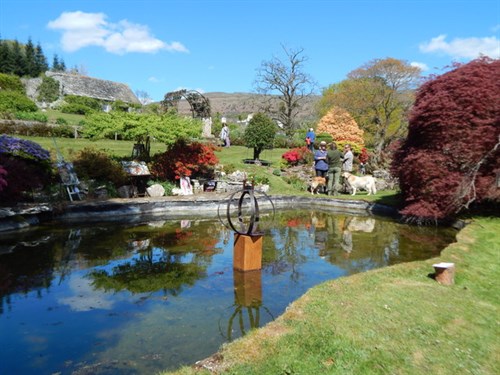
To round off a very rare Sunday outing we drove on to Monmouth
and the excellent Millbrook Garden Centre, privately owned, an
increasingly rare entity these days, and with many of the plants
grown on site. Just plants and all things gardening unlike all the
other paraphanelia usually encounterd in most garden centres. Well
sourced and reasonably priced and some little treasures always
waiting to be discovered by discerning gardeners. Helpful amd
knowledgeable staff too, Long may it floursih and the cosy cafe on
site.